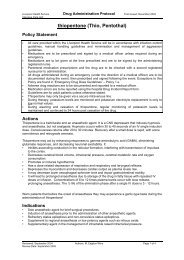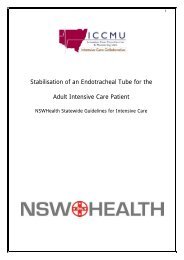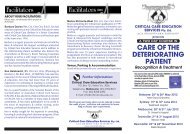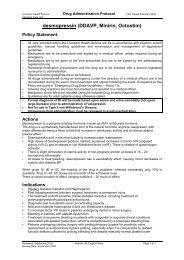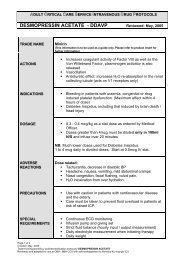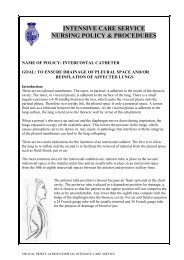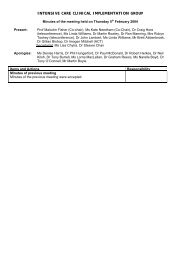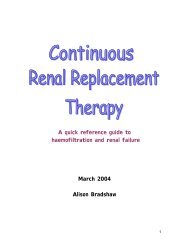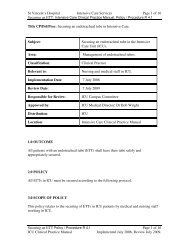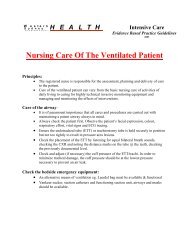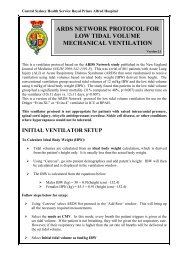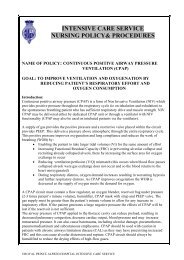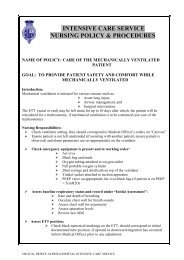Care of Cranio-cervical Traction - Intensive Care & Coordination ...
Care of Cranio-cervical Traction - Intensive Care & Coordination ...
Care of Cranio-cervical Traction - Intensive Care & Coordination ...
You also want an ePaper? Increase the reach of your titles
YUMPU automatically turns print PDFs into web optimized ePapers that Google loves.
Wentworth Area Health Service<br />
<strong>Care</strong> <strong>of</strong> <strong>Cranio</strong>-<strong>cervical</strong> <strong>Traction</strong><br />
Procedure Rationale<br />
day. If this pin is not protruding 1 to 2 mm traction will be lost leading potentially to<br />
then the tongs are too loose.<br />
spinal cord injury.<br />
The traction itself will be set up by either This to ensure the traction is set up<br />
the Neurosurgeon or senior<br />
correctly, and to reduce the risk <strong>of</strong> spinal<br />
Physiotherapist. The Neurosurgeon cord damage.<br />
should apply the initial weight to the<br />
traction. Any further modifications to the<br />
traction set up should be ordered and<br />
documented in the progress notes by the<br />
Neurosurgeon and carried out by either<br />
the Neurosurgeon himself, a senior<br />
Physiotherapist or by a senior member <strong>of</strong><br />
the Nursing staff<br />
For simple <strong>cervical</strong> immobilisation 10lbs<br />
(4.5kg) <strong>of</strong> weight is usually sufficient. For<br />
reduction <strong>of</strong> fracture or dislocation, an<br />
initial weight <strong>of</strong> 10lbs is used and<br />
increments <strong>of</strong> 5lbs (2.2kg) are added.<br />
This will vary from patient to patient and<br />
will be ordered by the Neurosurgeon and<br />
documented in the progress notes<br />
Directly after the initial traction is applied, This is to check that the traction applied<br />
and between any addition <strong>of</strong> weight, the is correct for that patient, and that the<br />
<strong>cervical</strong> spine should be x-rayed and <strong>cervical</strong> is in the alignment required.<br />
careful assessment <strong>of</strong> the patient’s<br />
neurological status attended.<br />
Ensure the weight is hanging freely. To ensure the patient is receiving the<br />
correct traction that was order by the<br />
Neurosurgeon.<br />
Ensure the ropes are knotted firmly and This is to prevent the traction from<br />
ends taped.<br />
coming undone.<br />
Ensure counter-traction is applied (the<br />
entire bed may be tipped slightly)<br />
Ensure the angle <strong>of</strong> pull is as directed by The position <strong>of</strong> the pins and the direction<br />
the Neurosurgeon.<br />
<strong>of</strong> the pull will decide if the patient’s neck<br />
is in slight flexion or slight extension.<br />
More commonly the neck will be held in a<br />
neutral position. This will be determined<br />
by the Neurosurgeon.<br />
Patients having <strong>cervical</strong> traction placed, Spinal Shock represents loss <strong>of</strong> reflex,<br />
or who already have the traction in place motor, sensory and autonomic activity<br />
should be carefully monitored for below the level <strong>of</strong> the spinal cord injury.<br />
changes in motor or sensory function. The heart rate and blood pressure will fall<br />
and parts <strong>of</strong> the body below the level <strong>of</strong><br />
the lesion are paralysed and without<br />
sensation. This can be assessed<br />
Motor function should be tested by Any change could mean dislodgement <strong>of</strong>




